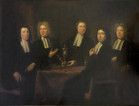News:
German Casino Hands Dutch Painting to Heirs of Nazi-Persecuted Art Dealer
By Catherine Hickley
A German casino will return a Dutch Old Master to the heirs of a Jewish art dealer persecuted by the Nazis and forced to flee Germany more than 70 years ago.

“The Masters of the Goldsmith Guild in Amsterdam in 1701,” by Juriaen Pool II, was in the Dusseldorf art gallery of Max Stern until 1937 -- the year Stern was forced to liquidate his gallery and flee Germany, according to Stern’s estate. The painting moved to a gallery in Wiesbaden and was bought by Spielbank Bad Neuenahr GmbH, located in a spa town south of Bonn, after World War II.
The estate is managed by three universities: Concordia and McGill in Montreal and the Hebrew University in Jerusalem. The Pool painting is only the ninth of about 400 missing works to be recovered. The handover will take place in a ceremony tomorrow at the Amsterdam Museum in the Dutch capital.
“We are in ongoing discussions with a number of other German organizations, including some major museums who also possess Stern works, and remain hopeful that more good news will follow,” Frederick Lowry, president and vice-chancellor of Concordia University, said in the statement sent by e-mail.
Stern, the proprietor of the Dusseldorf Galerie Julius Stern, was forced by the Nazis to liquidate his gallery and auction the contents -- more than 200 paintings, many of them Old Masters -- in a sale managed by the Cologne auction house Lempertz in 1937. Though the Pool painting was still in Stern’s possession in 1937, it wasn’t part of that sale.
Sale Under Duress
The exact details of Stern’s transaction with the Galerie Heinemann in Wiesbaden aren’t known, Clarence Epstein, director of special projects and cultural affairs at Concordia University, wrote in an e-mail.
“The evidence suggests that Stern sold the painting to Heinemann as part of his liquidation efforts, hence in a sale made under duress,” Epstein wrote.
Stern fled Germany shortly after the Lempertz auction and reached Paris in December 1937 with nothing but a suitcase. He set up a new art dealership, first in Britain and then later in Montreal. He died in 1987 without children, leaving the bulk of his estate to the universities.
In 2002, the colleges began a campaign to recover the lost art, creating the Max Stern Art Restitution Project, administered by Concordia. The Dutch government returned an oil painting by Jan Brueghel the Younger, “Allegory of Life and Water,” to the Max Stern estate last November.
Pool (1665-1745) was a portrait artist who became court painter to the Elector of Palatinate Johann Wilhelm.


